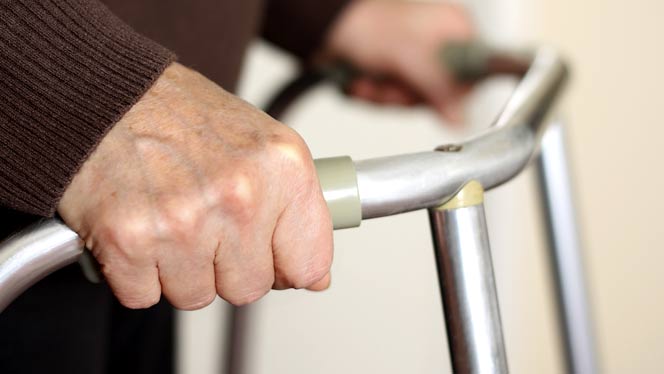How to safely lift your parent

One of our lovely readers, Jane, asked us the following question:
“How can I and my husband safely, and confidently, lift his 89 year old mum upright out of her chair, onto her zimmer frame, and then back into her commode seat, without damaging our backs or her?”
We don’t pretend to know all the answers so we asked one of our care experts to help us learn the right way to lift a less mobile relative out of their seat and assist them with walking.
It may come as a surprise to us all but it’s actually really bad practice to lift someone singlehandedly from a chair and then transfer them via zimmer frame to a commode. Whether it’s a trained carer or family member that’s doing the lifting it’s much better to use mechanical aids and other such lifting equipment so as not to risk the lift harming either person involved.
When gauging your parent’s mobility the best approach is to ask an occupational therapist (OT) to assess their needs and recommend the suitable apparatus accordingly. An occupational therapist treats physical and psychiatric conditions using specific activity to prevent disability and promote independent function in all aspects of daily life. The College of Occupational Therapists offers advice on how to find an occupational therapist but you should be able to arrange a visit from an OT quite easily through your parent’s GP.
If your parent’s carer is lifting them by themselves then they’re in danger of hurting your parent and themselves in the process. The carer could hurt their back and cause your parent to fall or both could fall together and be hurt quite badly. This scenario begs the question – who would be there to help them?
Electric chairs
Anyone assisting someone who is unable to get up out of a chair unaided should really have some form of mechanical aid such as an electric chair. Electric chairs can be raised and tilted making it easier for your parent to pull themselves out of the chair at a higher position. They enable your parent to be more independent despite mobility issues and allow for carers to safely manoeuvre your parent without a hands-on approach.
If your parent relies heavily on a zimmer frame they’ll be able to pull themselves forward out of their chair but they may need people either side of them to keep them steady. Your parent’s carers aren’t there to pull them up and although this may sound over-the-top a mechanical means of getting your parent on their feet such as a hoist, or stand aid, are the only way to ensure your parent isn’t hurt during the process of standing up. Older people tend to bruise more easily and their skin can tear as it’s a lot thinner than ours – both dangers (as well as the falling) if your parent is manually helped out of their chair.
Stand aids
If your parent isn’t strong enough to stand with the use of their zimmer frame and the help of an electric chair, then a stand aid may be the next best option. A stand aid usually has a belt or sling appendage that’s attached around your parent’s torso (under the arms and around the back of the body) which supports them whilst they’re lifted by a mechanical arm. The sling creates an active lifting motion that encourages user participation – your parent is helped by the stand aid to get up but they are using their own strength, they’re not overly reliant on the machine to do the work for them.
Hoists
Another option to help your parent out of their chair is an electric hoist. This is similar to the stand aid but is more supportive for those who are weaker and have difficulty standing from sitting. The hoist system uses a large sling that’s fitted under both your parent’s legs and around their back acting a bit like a hammock that’s mechanically winched up lifting and transferring your parent easily from a seated position to standing or to another chair or bed.
Maybe your parent already relies on a hoist or stand aid, maybe you’re thinking of buying one for them. Whatever the case make sure the person operating the hoist or stand aid is trained to do so. A carer who’s trained to use this equipment should be able to train/ show you how to operate it safely if you need to use it whilst caring for your parent. When your parent has mobility issues it’s advised to have two people present to help them, even when using electronic lifting devices.
Any mobility equipment that you get for your parent should be regularly maintained to ensure they’re safe for continual use. It’s good to bear in mind that each care company will have their own policies and training when it comes to the operation of assistive devices. The care co-operative I work with doesn’t teach their carers any physical lifts in order to actively discourage the hands-on lifting of clients.
More complex mobility issues, that aren’t simply about getting in and out of a chair, may require further treatment, advice from a GP or OT and the purchase of advanced equipment not covered in this article.
Your parent’s limited ability to get in and out of a chair may seem trivial but if they don’t receive the right help they can feel demotivated and depressed that their independence is slipping away. It can be a daunting task ensuring that your parent has the correct mobility equipment for their needs but it’s worth it just to know they’re happy and healthy.
If you found this article helpful why not join the family?

